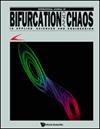双耦合伊齐克维奇神经元模型中结构不稳定的同步和边界碰撞分岔
IF 2.3
4区 数学
Q2 MATHEMATICS, INTERDISCIPLINARY APPLICATIONS
引用次数: 0
摘要
本研究探讨了在双耦合伊日科维奇神经元模型中观察到的结构不稳定同步现象。在接近观察到不稳定同步现象的参数空间区域内改变系统参数的结果是,我们发现其周期运动的稳定性发生了显著变化。我们推导出一个与原始模型等价的离散时间动力系统,并揭示了连续时间动力系统中的不稳定同步相当于相应离散时间系统中的边界碰撞分岔。此外,我们还提出了一种目标函数,可用于获得发生边界碰撞分岔的参数集。提出的目标函数是数值可微分的,可以用牛顿法求解。我们用数值方法生成了参数平面上的分岔图,其中包括边界碰撞分岔集。在图中,边界碰撞分叉集显示出一种新的分叉结构,类似于地质学中观察到的 "走向滑动断层"。这种结构意味着,在边界碰撞分叉发生前后,周期点的稳定性在某些情况下会发生不连续的变化,但在另一些情况下则会保持不变。此外,我们还证明了边界碰撞分叉集会在不同的点上连续出现分支。这种行为导致在边界碰撞分叉图中观察到树状结构;我们将这种结构称为边界碰撞分叉树。我们观察到,在离散时间动力系统中,一个周期点在边界碰撞分岔处消失,同时被另一个周期点取代;这一现象对应于连续时间动力系统中点火顺序的变化。本文章由计算机程序翻译,如有差异,请以英文原文为准。
Structurally Unstable Synchronization and Border-Collision Bifurcations in the Two-Coupled Izhikevich Neuron Model
This study investigates a structurally unstable synchronization phenomenon observed in the two-coupled Izhikevich neuron model. As the result of varying the system parameter in the region of parameter space close to where the unstable synchronization is observed, we find significant changes in the stability of its periodic motion. We derive a discrete-time dynamical system that is equivalent to the original model and reveal that the unstable synchronization in the continuous-time dynamical system is equivalent to border-collision bifurcations in the corresponding discrete-time system. Furthermore, we propose an objective function that can be used to obtain the parameter set at which the border-collision bifurcation occurs. The proposed objective function is numerically differentiable and can be solved using Newton’s method. We numerically generate a bifurcation diagram in the parameter plane, including the border-collision bifurcation sets. In the diagram, the border-collision bifurcation sets show a novel bifurcation structure that resembles the “strike-slip fault” observed in geology. This structure implies that, before and after the border-collision bifurcation occurs, the stability of the periodic point discontinuously changes in some cases but maintains in other cases. In addition, we demonstrate that a border-collision bifurcation set successively branches at distinct points. This behavior results in a tree-like structure being observed in the border-collision bifurcation diagram; we refer to this structure as a border-collision bifurcation tree. We observe that a periodic point disappears at the border-collision bifurcation in the discrete-time dynamical system and is simultaneously replaced by another periodic point; this phenomenon corresponds to a change in the firing order in the continuous-time dynamical system.
求助全文
通过发布文献求助,成功后即可免费获取论文全文。
去求助
来源期刊
CiteScore
4.10
自引率
13.60%
发文量
237
审稿时长
2-4 weeks
期刊介绍:
The International Journal of Bifurcation and Chaos is widely regarded as a leading journal in the exciting fields of chaos theory and nonlinear science. Represented by an international editorial board comprising top researchers from a wide variety of disciplines, it is setting high standards in scientific and production quality. The journal has been reputedly acclaimed by the scientific community around the world, and has featured many important papers by leading researchers from various areas of applied sciences and engineering.
The discipline of chaos theory has created a universal paradigm, a scientific parlance, and a mathematical tool for grappling with complex dynamical phenomena. In every field of applied sciences (astronomy, atmospheric sciences, biology, chemistry, economics, geophysics, life and medical sciences, physics, social sciences, ecology, etc.) and engineering (aerospace, chemical, electronic, civil, computer, information, mechanical, software, telecommunication, etc.), the local and global manifestations of chaos and bifurcation have burst forth in an unprecedented universality, linking scientists heretofore unfamiliar with one another''s fields, and offering an opportunity to reshape our grasp of reality.

 求助内容:
求助内容: 应助结果提醒方式:
应助结果提醒方式:


